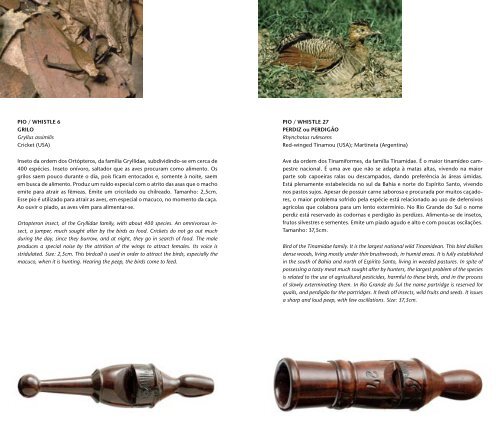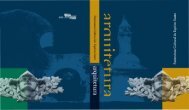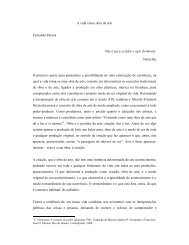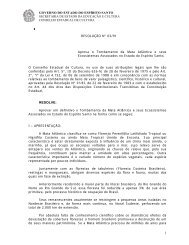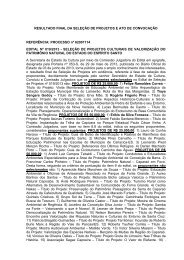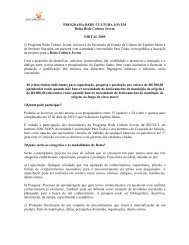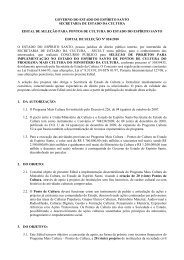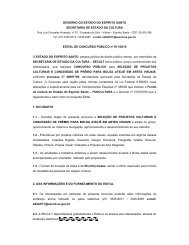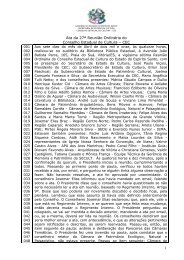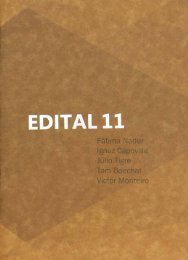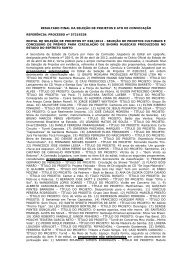Create successful ePaper yourself
Turn your PDF publications into a flip-book with our unique Google optimized e-Paper software.
PIO / WHISTLE 6<br />
GRILO<br />
Gryllus assimilis<br />
Cricket (USA)<br />
Inseto da ordem dos Ortópteros, da família Gryllidae, subdividindo-se em cerca de<br />
400 espécies. Inseto onívoro, saltador que as aves procuram como alimento. Os<br />
grilos saem pouco durante o dia, pois ficam entocados e, somente à noite, saem<br />
em busca de alimento. Produz um ruído especial com o atrito das asas que o macho<br />
emite <strong>para</strong> atrair as fêmeas. Emite um cricrilado ou chilreado. Tamanho: 2,5cm.<br />
Esse pio é utilizado <strong>para</strong> atrair as aves, em especial o macuco, no momento da caça.<br />
Ao ouvir o piado, as aves vêm <strong>para</strong> alimentar-se.<br />
Ortopteron insect, of the Gryllidae family, with about 400 species. An omnivorous insect,<br />
a jumper, much sought after by the birds as food. Crickets do not go out much<br />
during the day, since they burrow, and at night, they go in search of food. The male<br />
produces a special noise by the attrition of the wings to attract females. Its voice is<br />
stridulated. Size: 2,5cm. This birdcall is used in order to attract the birds, especially the<br />
macuco, when it is hunting. Hearing the peep, the birds come to feed.<br />
PIO / WHISTLE 27<br />
PERDIZ ou PERDIGÃO<br />
Rhynchotus rufescens<br />
Red-winged Tinamou (USA); Martineta (Argentina)<br />
Ave da ordem dos Tinamiformes, da família Tinamidae. É o maior tinamídeo campestre<br />
nacional. É uma ave que não se adapta à matas altas, vivendo na maior<br />
parte sob capoeiras ralas ou descampados, dando preferência às áreas úmidas.<br />
Está plenamente estabelecida no sul da Bahia e norte do Espírito Santo, vivendo<br />
nos pastos sujos. Apesar de possuir carne saborosa e procurada por muitos caçadores,<br />
o maior problema sofrido pela espécie está relacionado ao uso de defensivos<br />
agrícolas que colabora <strong>para</strong> um lento extermínio. No Rio Grande do Sul o nome<br />
perdiz está reservado às codornas e perdigão às perdizes. Alimenta-se de insetos,<br />
frutos silvestres e sementes. Emite um piado agudo e alto e com poucas oscilações.<br />
Tamanho: 37,5cm.<br />
Bird of the Tinamidae family. It is the largest national wild Tinamidean. This bird dislikes<br />
dense woods, living mostly under thin brushwoods, in humid areas. It is fully established<br />
in the south of Bahia and north of Espírito Santo, living in weeded pastures. In spite of<br />
possessing a tasty meat much sought after by hunters, the largest problem of the species<br />
is related to the use of agricultural pesticides, harmful to these birds, and in the process<br />
of slowly exterminating them. In Rio Grande do Sul the name partridge is reserved for<br />
quails, and perdigão for the partridges. It feeds off insects, wild fruits and seeds. It issues<br />
a sharp and loud peep, with few oscillations. Size: 37,5cm.


